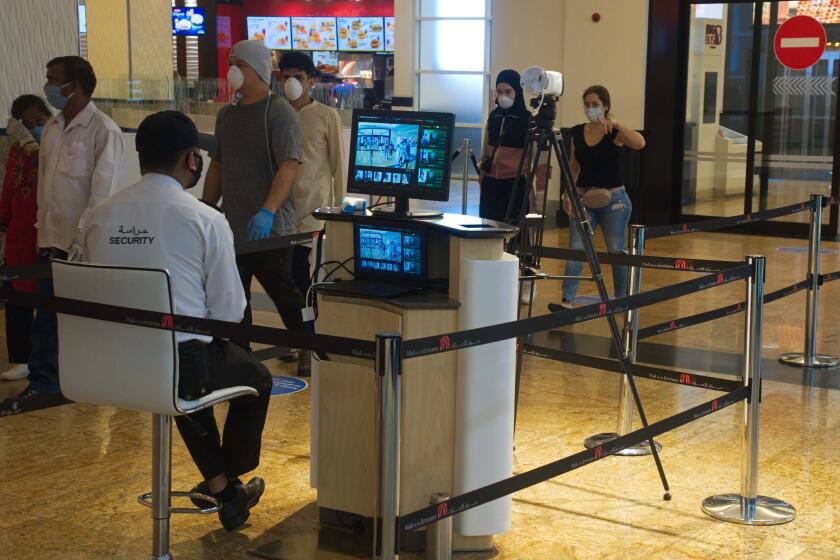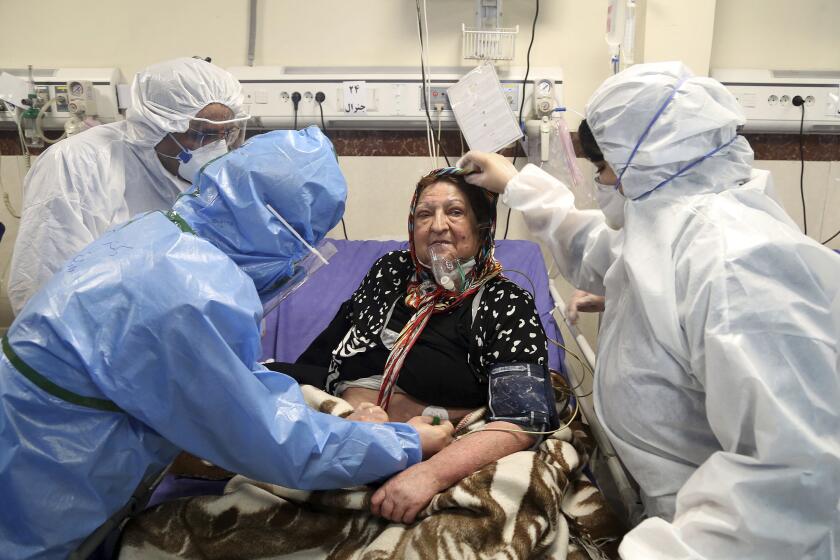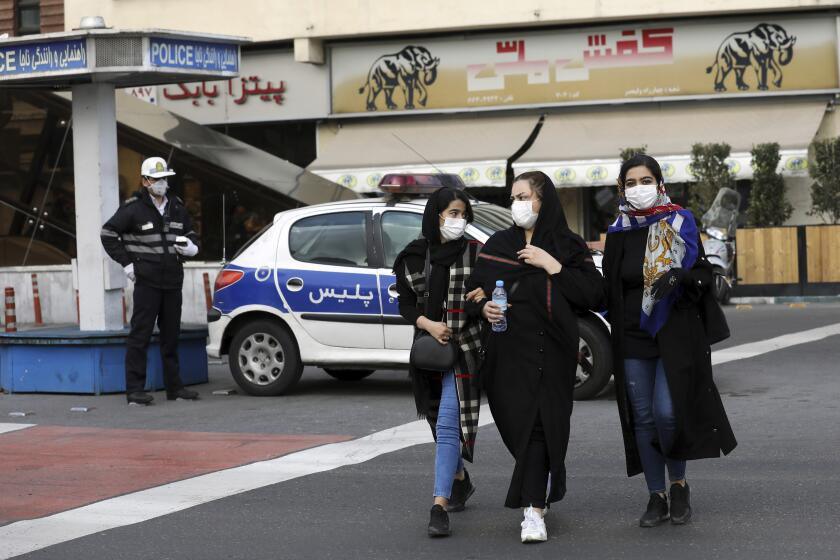These two countries are tiny, rich and have the world’s highest coronavirus infection rates

- Share via
DUBAI, United Arab Emirates — The tiny neighboring Middle Eastern sheikdoms of Bahrain and Qatar have the world’s highest per-capita rates of coronavirus infections, fueled initially by the virus sweeping undetected through camps housing healthy young migrant workers, studies show. But both countries’ COVID-19 fatality rates remain strikingly low.
In Qatar, a new study found that nearly 60% of those testing positive showed no symptoms at all, calling into question the usefulness of mass temperature checks meant to stop the infected from mingling with others. In Bahrain, authorities put the asymptomatic figure even higher, at 68%.
These results reflect both the wider problems faced by Gulf Arab countries reliant on cheap foreign labor and their relative success in tracking their COVID-19 outbreaks, given their oil wealth and authoritarian governments.
Aggressive testing boosted the number of confirmed cases as health officials in Bahrain and Qatar targeted vulnerable labor camps and neighborhoods, where migrant workers from Asia sleep, eat and live up to a dozen people per room.
“This is why globally we failed to control ... the infection, because simply the response has been focused on trying to find cases and isolate them and quarantine their contacts,” said Laith Abu Raddad, a disease researcher at Weill Cornell Medicine in Qatar. “If most people getting the infection are actually spreading the infection without even knowing it, this really does not actually work.”
The island kingdom of Bahrain and the peninsular nation of Qatar have been locked in a years-long political dispute that’s ended travel and trade between two countries only miles apart. Yet similarities abound in these U.S.-allied nations — Bahrain hosts the U.S. Navy’s 5th Fleet while Qatar hosts the forward headquarters of the U.S. military’s Central Command at its sprawling Al Udeid Air Base.
The coronavirus crisis has led to some tentative attempts at cooperation between Arab nations and Israel, which many of them do not recognize.
Both rely heavily on foreign labor, whether white-collar workers in banks or blue-collar laborers scaling scaffolding on construction sites. Qatar in particular embarked on a massive construction boom ahead of hosting the 2022 FIFA World Cup.
The coronavirus found a conducive environment in the cramped quarters that migrant workers live in while trying to save money to send back home.
In Qatar, nearly 30% of those found infected were from India, while 18% were Nepalis and 14% were Bangladeshis, according to a study by Abu Raddad and others.
Of the more than 6,000 contact trace cases that Bahrain published, more than 2,600 involved Indian nationals, while 1,310 were Bahrainis and 1,260 were Bangladeshis. More than 400 came from Pakistan, with a similar number from Nepal.
In the battle for regional influence, coronavirus worries make Middle East countries vulnerable to disinformation campaigns.
Those figures in Bahrain and Qatar likely track across the wider Gulf Cooperation Council, the regional bloc that also includes Kuwait, Oman, Saudi Arabia and the United Arab Emirates, all of which rely on a vast foreign labor pool already sickened and trapped by the virus.
Though other GCC nations haven’t broken down coronavirus cases by nationalities, a recently published article in the Oman Medical Journal said that, of the sultanate’s first 1,304 cases of the coronavirus, 29% of patients were Indian, 20% Bangladeshi and 10% Pakistani.
Their living conditions likely make them more at risk of contracting the virus, as Bahrainis and Qataris usually live in single-family homes.
Qatar, with a population of 2.8 million people, has reported more than 107,000 cases of the coronavirus and 163 deaths. Bahrain, with a population of 1.6 million, has reported more than 37,000 cases and 130 deaths.
Strikingly, the fatality rate in the two countries remains low, with Qatar at 0.15% and Bahrain at 0.34%. The U.S. rate is around 3.6%.
The coronavirus outbreak has erupted into the Islamic Republic’s latest image crisis. The government’s handling of the virus’ spread is a critical test not only for its healthcare industry but also for its political legitimacy.
Both Abu Raddad and Ghina Mumtaz, a disease researcher at the American University of Beirut, attribute that in part to the youth of the laborers in both Bahrain and Qatar.
“If you look at the infection fatality rate, you will realize that it’s not as scary as if you look only at the figure of the number of cases per capita,” Mumtaz said.
In response to questions from the Associated Press about their outbreaks, both Bahrain and Qatar attributed their high case numbers to having some of the world’s best per-capita testing rates. Qatar also compared itself to Singapore, which similarly had COVID-19 outbreaks among its migrant laborers.
Bahrain said its government’s “preemptive testing strategy means that the vast majority of cases are identified prior to the development of symptoms.” Authorities there also moved 8,000 laborers to new accommodations, disinfected housing and implemented a rule prohibiting more than five laborers per room, with about 10 feet of space for each one.
Qatar now allows a maximum of four laborers per shared room with at least 64 square feet per occupant.
But finding that the majority of those infected are asymptomatic raises questions about the effectiveness of checking only people seeking medical care for symptoms or checking people through the use of temperature-taking and thermal screening.
Of the Bahrain contract trace cases, over 2,000 came “as part of a campaign to obtain random samples from the community,” the database showed. More than 1,300 were foreign workers tested while the area they lived in faced mandatory quarantine orders.
The high number of asymptomatic individuals in both sheikdoms means that once the coronavirus reaches a new population, it greatly raises the risk of people unknowingly spreading it while feeling fine.
“You are talking only about the spark to a fire,” Abu Raddad said.
More to Read
Sign up for Essential California
The most important California stories and recommendations in your inbox every morning.
You may occasionally receive promotional content from the Los Angeles Times.
















